Abstract
Digital image correlation has been used, in conjunction with Mode I and Mode II fracture mechanics tests under static and dynamic loading conditions, to determine the position of the crack front during interlaminar testing. A MATLAB code has been developed to post process the digital image correlation analysis to determine the experimentally measured crack position and these results have been compared to compliance-based predictions of crack position which do not use a physical measure of the crack length. Results have shown that the digital image correlation analysis has successfully tracked the crack position providing a physical measure of the crack front during static and dynamic testing for the calculation of fracture toughness values. This methodology, incorporating digital image correlation for crack position monitoring, was then expanded to analyses for fatigue tests showing that the physical crack length has a varied growth rate in comparison to the steady change in specimen compliance.
1. Introduction
Composite materials have gained widespread acceptance in aerospace and automotive industries since their initial introduction in the early 1950s. However, they are especially susceptible to low velocity impacts, with delamination being the most commonly observed failure mechanism within the laminate structure [1,2,3]. The resulting loss of strength and stiffness, stemming from delamination, can result in failure of the component and detrimental damage to the entire structure. Thus, an understanding of the intrinsic material properties which govern these failures, both under static and dynamic loading conditions, and the design principles that should be employed to limit these failures is of paramount importance.
To this end, fracture mechanics testing of carbon fibre epoxy composites has been conducted under static and fatigue loading conditions for Mode I and Mode II analyses using the double cantilever beam test (DCB) and the end load split test (ELS) in conjunction with digital image correlation techniques (DIC) for automated crack growth monitoring and subsequent fracture toughness measurements. DIC is a non-destructive optical measurement technique that provides an analysis of the displacements and strain fields on the surface of a sample under an applied loading [4,5].
Results have shown that DIC can be used to effectively monitor the position and movement of the crack front using the “sigma” coefficient which relates the quality of the pixel correlation to the reference image. Thus, by using a threshold value of sigma, the location of the crack front and its subsequent growth can be used in conjunction with the measured load and displacement to calculate the fracture toughness of the sample.
The effect of subset and step sizes on DIC accuracy has been assessed with comparisons drawn between different analyses. Tests have been conducted to identify the static fracture toughness and confirm the viability of the defined methodology, and this has been expanded to crack measurements in dynamic (fatigue) tests with results compared to traditional compliance-based methods to highlight the benefits of adopting DIC techniques in standardised test methods.
2. Materials and Methods
2.1. Materials
The material tested throughout this research was a unidirectional [0°]18 carbon fibre reinforced plastic with a thermoset epoxy matrix. A Teflon insert was placed between the middle two layers of laminate (for the initiation precrack which was approximately 50.00 mm long with load block corrections included). Specimens were cut from preformed plates, provided by Honda R&D Co., Ltd. and Mitsubishi Chemical Corporation, Japan, and were approximately 4.20 mm thick, 25.00 mm wide, and 125.00 mm long, which is consistent with the dimensions outlined in ASTM D5528 [6] and ISO 15114 [7] for Mode I and Mode II specimens respectively. A speckle pattern was applied to one side of the sample, along with a length tab which defined the crack length position in the sample for visual observations.
2.2. Test Methods
Mode I delamination testing was undertaken using the double cantilever beam (DCB) test as outlined in ASTM D5528 [6] and pictured in Figure 1a. Mode II testing was conducted using the end load split (ELS) test, outlined in ISO 15114 [7] and pictured in Figure 1b. All static tests were performed at a constant crosshead displacement of 0.02 mm/s (1.2 mm/min) with 5 specimens tested for each loading configuration. Precracking was undertaken for the static Mode I specimens, but not for the fatigue specimens. This is to mitigate fibre bridging [8] which can occur during precracking and would inadvertently increase the measured fracture toughness which is consistent with defined test methods [9]. Precracking was undertaken for all Mode II tests (static and fatigue). The average critical energy release rate GC was then used to determine the load levels for the subsequent fatigue tests in both loading modes. Fatigue tests were conducted at frequencies of 10 Hz (Mode I) and 5 Hz (Mode II), and at an R-Ratio of 0.1. Load levels were set based on the measured static values, with three specimens tested per load level.
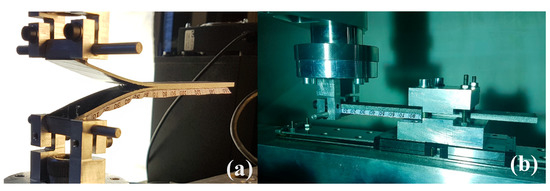
Figure 1.
Delamination testing setups for (a) Mode I DCB tests and (b) Mode II ELS tests.
2.3. Digital Image Correlation
For the current test setup, two cameras were positioned facing the side of the test sample such that 3-dimensional information could be captured. For the static tests, the DIC system took a single image (one from each camera), every second for the duration of the tests, with the specifics of the 3D-DIC system used outlined in Table 1. Each image was saved with the corresponding load and displacement measured at that point in time for the test such that fracture toughness calculations could be made. For the fatigue tests, the DIC system took an image at the maximum displacement of the sample at specific cycle points. This allows for the maximum amount of information to be captured while limiting the file sizes to manageable quantities. This test methodology has the significant advantage that the test does not have to be stopped to measure the crack position, thus eliminating the need for operator interference and allowing the test to run to completion.

Table 1.
DIC system configuration information for static and fatigue tests.
2.4. MATLAB Data Analysis
The analysis of all results is undertaken using an automated MATLAB software code which calculates various outputs from the static and fatigue tests. It incorporates the measured load and displacement data with the DIC analysis to determine the crack front position through the use of a threshold “sigma” value, above which a crack is defined as present. This threshold value is set just above the noise level of the analysis so that the measurement is sensitive to discrepancies in the measured value of sigma. Thus, by taking all of this data, the fracture toughness at all of the individual points in the test can be analysed using both physical crack measurements and compliance-based methodologies to determine the fracture toughness of the material in both Mode I and Mode II configurations.
3. Results
3.1. Subset and Step Size
The first step towards measuring the crack front position centered on defining the threshold value of sigma for which a value above this setpoint would be considered as a damaged material and would indicate the location of the crack front, Figure 2. For this analysis, the same Mode I DIC test was assessed for differing subset sizes and step sizes to determine the effects of variations in these parameters on the location of the crack front. Subset sizes were varied from a 29 × 29 pixel area down to an 11 × 11 pixel area with step sizes ranging from 7 pixels down to 3 pixels and a constant sigma threshold value of 0.01 pixels.
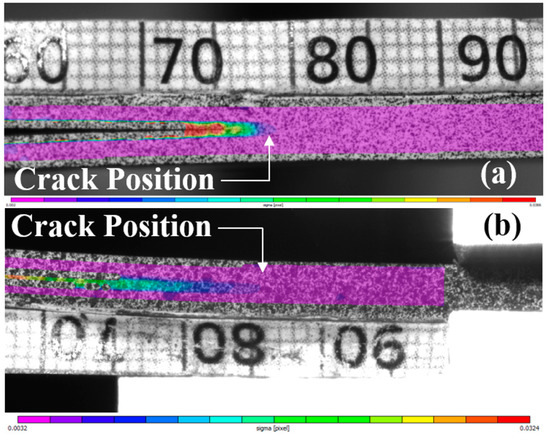
Figure 2.
Crack front monitoring in (a) Mode I and (b) Mode II loading configurations using the confidence in pixel correlation, “sigma”, to define the crack front position.
From the results of the DIC analysis, Figure 3, decreasing the subset size resulted in an increase in measured crack length, while decreasing step size resulted in a reduction in the measured crack length for each constituent analysis. Decreasing the subset size is equivalent to decreasing the mesh size, and so smaller deviations in crack length can be tracked, hence the smaller subsets predicted larger crack lengths. Decreasing the step size had the opposite effect, where by the measured crack length was reduced with lower step size. In this case, the step size, or the distance between subset data points, controls the independence of the results in each subset data point. Lower step values equate to a higher overlap and a loss of independent information, and so higher step sizes increase the independence of individual subset measurements. It is for this reason that higher step values are taken as more accurate due to their higher level of independence. Step sizes of at least 0.25–0.33 times the subset size were used as per best practice guidelines.
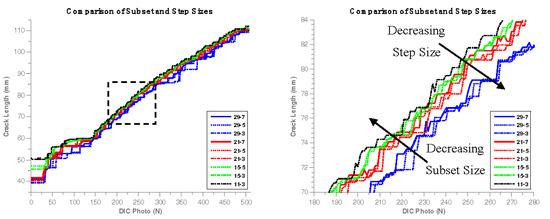
Figure 3.
DIC measured crack lengths using sigma for differing subset sizes (first number in pixels) and step sizes (second number in pixels) in the same Mode I static test, with a close-up view of the effects of subset size and step size on measured crack lengths.
3.2. Static Test Results
Static test results were compared between the physically measured crack position and the compliance-based measurement techniques (whereby beam theory was used to theoretically predict the crack length using the geometry of the specimen). For Mode I tests, the results are all based on physical measures of the crack position, Figure 4a, with small discrepancies between results. However, for the Mode II results, the compliance-based schemes have predicted higher fracture toughness values for static test results than the DIC measured results, leaving the DIC results to predict a more conservative value for the measured Mode II fracture toughness, Figure 4b.
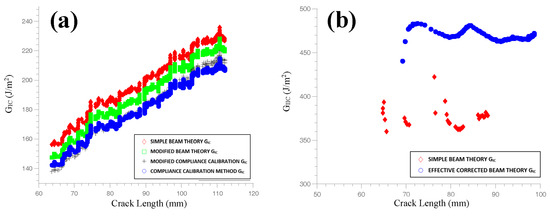
Figure 4.
Static test result for (a) Mode I and (b) Mode II interlaminar testing showing the fracture toughness values calculated with different fracture toughness measurement methodologies.
3.3. Fatigue Test Results
Following the successful usage of DIC for crack position monitoring in static tests, the same methodology was applied to fatigue tests in both loading modes, Figure 5. The DIC system was capable of tracking the crack growth during fatigue cycles with the images taken at the maximum displacement point of the cycle. The results in Figure 5 demonstrate the variable nature of the crack growth in each loading Mode, with jumps in crack length visible at different points. In comparison, the compliance of each specimen shows a steady increase and as such does not capture the variable nature of the physical crack growth. These results demonstrate the benefits of using DIC systems for delamination testing in static and dynamic loading configurations while also providing a more scientifically repeatable measure of the crack front position.
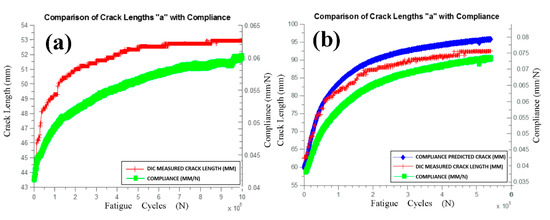
Figure 5.
Fatigue test results for (a) Mode I and (b) Mode II tests showing the crack length versus number of cycles for DIC based measurements (red) and compliance-based measurements (blue).
4. Discussion and Conclusions
DIC has been shown to be effective for measuring the crack front position in Mode I and Mode II loading configurations. The use of a threshold “sigma” value in conjunction with varying subset and step sizes has demonstrated that lower subset sizes and higher step sizes result in improved measurements for the location of the crack position. Testing using DIC techniques has comparable results to compliance-based predictions with more conservative values measured in Mode II tests. The developed technique has been expanded to static and dynamic loading conditions and has shown significant promise for incorporation into future standard test methods for interlaminar failure analyses.
Author Contributions
The authors, as a whole, conceived and designed the experiments; B.R.M., S.F., and K.A.K. performed the experiments; B.R.M. and S.F. analyzed the data; B.R.M., L.P., and D.C.P. reviewed the analysis and gave technical input throughout testing; B.R.M. wrote the paper.
Acknowledgments
The work leading to this publication has been funded by the SBO project “M3Strength”, which fits in the MacroModelMat (M3) research program funded by SIM (Strategic Initiative Materials in Flanders) and VLAIO (Flanders Innovation & Entrepreneurship). The authors would also like to thank the Honda R&D Co., Ltd., Mitsubishi Chemical Corporation, and Siemens PLM Software, Belgium for supplying materials and their continued technical support.
Conflicts of Interest
The authors declare no conflict of interest. The founding sponsors had no role in the design of the study; in the collection, analyses, or interpretation of data; in the writing of the manuscript. The consortium of people involved in the M3 program and the material suppliers have accepted the publication of the results.
References
- Murri, G.B.; Martin, R.H. Effect of initial delamination on Mode 1 and Mode 2 interlaminar fracture toughness and fatigue fracture threshold. Compos. Mater. Fatigue Fract. 1991, 38, 239–256. [Google Scholar]
- O’Brien, T.K. Composite Interlaminar Shear Fracture Toughness, GIIC: Shear Measurement of Sheer Myth? NASA TM-110280; NASA Langley Research Center: Hampton, VA, USA, 1997. [Google Scholar]
- Brunner, A.J.; Murphy, N.; Pinter, G. Development of a standardized procedure for the characterization of interlaminar delamination propagation in advanced composites under fatigue mode I. loading conditions. Eng. Fract. Mech. 2009, 76, 2678–2689. [Google Scholar] [CrossRef]
- Lakshmi Aparna, M.; Chaitanya, G.; Srinivas, K.; Rao, J.A. Fatigue Testing of Continuous GFRP Composites Using Digital Image Correlation (DIC) Technique a Review. Mater. Today Proc. 2015, 2, 3125–3131. [Google Scholar] [CrossRef]
- Reiner, J.; Torres, J.P.; Veidt, M. A novel Top Surface Analysis method for Mode I interface characterisation using Digital Image Correlation. Eng. Fract. Mech. 2017, 173, 107–117. [Google Scholar] [CrossRef]
- ASTM D5528. Standard Test Method for Mode I Interlaminar Fracture Toughness of Unidirectional Fiber-Reinforced Polymer Matrix Composites. Am. Stand. Test. Meth. 2014, 3, 1–12. [Google Scholar]
- ISO Standard 15114-2014. Fibre Reinforced Plastic Composites—Determination of the Mode II Fracture Resistance for Unidirectionally Reinforced Materials Using the Calibrated End-Loaded Split (C-ELS) Test and an Effective Crack Length Approach; International Standards Organsiation: Geneva, Switzerland, 2014. [Google Scholar]
- Khan, R.; Alderliesten, R.; Yao, L.; Benedictus, R. Crack closure and fibre bridging during delamination growth in carbon fibre/epoxy laminates under mode I fatigue loading. Compos. Part A Appl. Sci. Manuf. 2014, 67, 201–211. [Google Scholar] [CrossRef]
- ASTM D6115. Standard test method for mode I fatigue delamination growth onset of unidirectional fibre-reinforced polymer matrix composites. Am. Soc. Test. Mater. 2001, 15, 1–6. [Google Scholar]
Publisher’s Note: MDPI stays neutral with regard to jurisdictional claims in published maps and institutional affiliations. |
© 2018 by the authors. Licensee MDPI, Basel, Switzerland. This article is an open access article distributed under the terms and conditions of the Creative Commons Attribution (CC BY) license (https://creativecommons.org/licenses/by/4.0/).